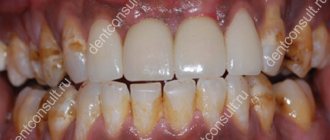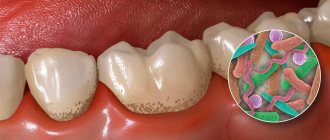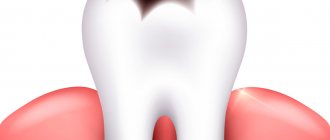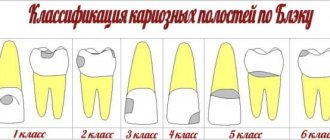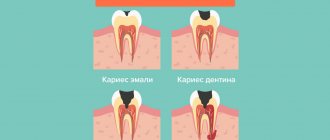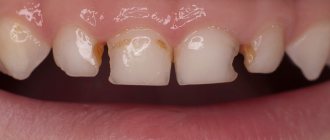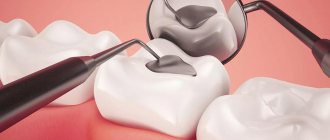Conservative treatment methods
Gentle, conservative methods of treating caries, that is, treating caries without traditional drilling of teeth with a drill, are applicable at the earliest stage of the disease - the stage of a white (or chalky) spot, although in a number of cases these methods are also applicable at the stage of superficial caries.
Tooth enamel consists of 97% minerals, calcium, phosphorus and fluorine compounds that form crystals of hydroxyapatite - the hardest substance in the human body. However, these substances can be destroyed by the action of acids released by cariogenic microflora. Remineralization of teeth, that is, replenishment and restoration of calcium, phosphorus and fluorine compounds, forms the basis of conservative treatment of initial caries. With timely use, artificial remineralization significantly slows down the carious process and in many cases can reverse it; This is not only an effective method of conservative treatment, but also an important element in the prevention of caries.
There are several types of remineralizing procedures, which are prescribed depending on the patient’s indications and budget. During the procedure, the tooth surface, previously cleaned of plaque and tartar, is treated several times with special compounds (pastes, gels, varnishes) containing calcium and phosphorus. When fluoridation or deep fluoridation of teeth, compositions containing fluoride compounds are used. The corresponding compositions are applied to the teeth either with a special brush, or silicone trays with fluoride-containing gel are temporarily placed on the patient’s teeth.
Reasons for development
Caries is a slow but complex pathological process that occurs in the hard tissue of the tooth. It develops under the influence of a complex of negative internal and external factors that provoke the dissolution of mineral microelements in the tissues.
It is believed that caries occurs due to poor oral hygiene, however, insufficient dental care is a secondary factor, since exposure to other factors is necessary for the infection to cause carious lesions.
Factors that provoke caries include internal processes, the disruption of which leads to a decrease in the resistance of hard tissues to infection:
- weakening of general and local immunity;
- lack of calcium, vitamins and other minerals;
- inflammatory processes not only in the oral cavity, but throughout the entire body.
The activity of the infection can be affected by eating large amounts of sweet or starchy foods, smoking, using drugs or alcohol, and trauma to tooth enamel. A hereditary factor and congenital abnormalities (for example, hypoplasia of tooth enamel) cannot be excluded.
According to statistics, caries is diagnosed in 98% of the total population. For effective treatment, it is necessary not only to eliminate the affected tissues, but also the causes of the disease.
Filling a cavity
Teeth filling is performed by filling the prepared cavity with a special filling material. Modern dentistry has several types of fillings with different properties at its disposal, these are:
Gold
Many dentists still consider gold to be the best filling material. A gold filling is well tolerated by the gum tissue and can last twenty years or more.
Amalgam
Amalgam fillings are wear-resistant and relatively inexpensive. True, because of their dark color, they are preferred to be installed in places where they are invisible.
Lighting composite materials
Today, lighting composites are the most common material all over the world. During filling, filling material made from composites is applied in several stages in layers, and each layer is illuminated for polymerization and hardening. With the help of light-based composite materials, you can not only place fillings, but also carry out full restoration of teeth, reproducing their natural shapes and colors.
Porcelain
Porcelain restoration is used in cases where it is necessary to cover a large part of the tooth. Porcelain fillings (also called inlays) can be matched to the natural color of the tooth and are resistant to staining.
Fillings can be permanent or temporary. Temporary fillings are used in cases where caries treatment occurs in two stages. When treating deep caries, when there is a suspicion that the carious process may have affected the pulp, a temporary filling is first installed, and if signs of an inflammatory process do not appear within several days, the temporary filling is replaced with a permanent one.
Peculiarities
Treatment of dental caries depends on the characteristics of its development. In dentistry, pathology is classified according to the depth of the lesion, type of development and affected area.
Stages of caries (according to the depth of the lesion):
- darkening of the enamel - the formation of matte spots on the tooth enamel with subsequent progression of pigmentation;
- superficial - formation of enamel lesions;
- medium - spread of the pathological process to dentin tissue, severe carious lesions with the appearance of dark spots and holes in the tooth;
- deep - the pathology already affects the entire dentin and causes inflammation of the pulp tissue.
The disease is divided into a primary type, when treatment has not yet been carried out, and a secondary type, which involves relapse of caries after filling.
The choice of treatment method is also influenced by the area that has undergone the pathological process: enamel, dentin or the surface of the tooth root. Basically, the area of localization depends on the stage of dental disease.
Caries is also classified into types:
- cervical (peri-gingival tissue);
- fissure (indentations in the tooth enamel);
- interdental (between teeth).
Caries has the ability to spread not only to adjacent teeth, but also to the upper-lower teeth. Since the process is infectious, it easily passes from one tooth to another, as well as to the mucous and soft tissues of the oral cavity, thereby provoking other dental diseases.
Sign up for a free consultation by phone +7(495)150-30-01
Examples of “Before” works
Examples of “After” works
Diagnostics
The principles of treatment of dental caries are based on the clinical picture, information about which becomes available as a result of diagnosis.
The fight against carious lesions at the Dentpremium clinic begins with making an appointment with a dentist-therapist, visiting a doctor’s office and consulting. At the appointment, the doctor examines the oral cavity for obvious signs of caries. If there are no symptoms, but the patient has complaints, additional methods are used.
Our dental center offers diagnostics using modern methods using the latest technologies, which make it possible to quickly determine the affected area and the location of caries.
Dental therapist's opinion
Caries is a problem that almost every dental patient faces. Today we have many effective and low-traumatic treatment methods that are aimed primarily at preserving the patient’s own tooth. Removal is the most recent and undesirable option, which every practicing doctor still has to resort to from time to time. In the future, for the patient after tooth extraction, there is implantation and prosthetics, which is expensive, painful and not accessible to everyone.
Therefore, preventive treatment is the key to oral health at any age. No need to be afraid of pain! The doctor, using modern equipment and anesthesia, performs all manipulations taking into account the patient’s comfort. Visit your dentist every six months for preventative care, and you can avoid a number of serious problems and complications of caries.
What happens if caries is not treated?
Caries is a source of infection in the body. If it is not eliminated, then both local and general complications are possible:
- Local complications - the infection moves deeper after the destruction of the crown. First, painful pulpitis develops, and then, if you continue to ignore the toothache and suppress it with pills, the infection moves through the root canals to the apex of the root and spreads to the periodontium. Long-term periodontitis means severe pain and the risk of developing such serious, life-threatening complications as abscesses, osteomyelitis (inflammation of bone tissue), and meningitis.
- Common complications are the penetration of infection into the vascular system with spread throughout the body. The development of infectious and inflammatory processes in any organs and tissues is possible. Very often, carious teeth are the source of severe infectious and allergic processes, such as glomerulonephritis, myocarditis, etc.
All these complications can be eliminated only by timely treatment of caries.
Types of filling material
Initially, mineral cements, acrylic and epoxy resins, and amalgams were used to make fillings. In modern dentistry, fillings that are imperfect in aesthetics and fixation have been replaced by materials that are durable and biocompatible with the human body. Composites, glass ionomer cements, compomers.
Basically, for all types of fillings a mixture of several materials is used. Composite light fillings have a complex chemical composition: heliocomposite, filler, binding elements. The use of nanocomposite materials in dental practice allows specialists to restore damaged teeth with greater efficiency. Combining in one material, ultrafine particles and large nanoclusters achieve high fullness. This structure provides maximum strength and allows for excellent aesthetics. They are characterized by excellent polishability and long lasting shine of the restoration.
Get a consultation
We will answer all your questions before visiting the clinic!
+7
Online registration
Medical treatment of carious cavity
The formed recess, after removing cariogenic bacteria and damaged tissues, is treated with antiseptic agents.
Restoration of interdental contacts
When caries is located on a surface in contact with adjacent teeth, it is necessary to restore the side wall of the tooth. In this case, another stage is added - the installation of special devices (wedges and a matrix) that will help form tight contact and prevent pieces of food from getting stuck.
Acid treatment of enamel
Etching the cavity is necessary to create micropores so that the adhesive that will be used to coat hard tissue in the next step can penetrate deeper. A gel based on phosphoric acid is used. After application, the entire gel should be completely washed off with water, and the tooth surface should be slightly dried with a dryer.
Treatment of dentin and enamel with a special adhesive
For high-quality fixation of a permanent nanocomposite light filling, the cavity is treated with a special adhesive (bond). After absorption, it is illuminated with a UV lamp.
Applying a gasket under the filling material
For injuries at the middle and deep stages, an insulating gasket - glass ionomer cement - is placed at the bottom of the cavity (due to the close location of the neurovascular bundle). It contains tissue-nutrient microelements - fluorine and calcium.
Installing a seal
Installing a filling is an important condition for restoring the aesthetic parameters of a tooth, as well as its shape and functionality. As a rule, light-curing composites are used for this purpose. They are applied using a layer-by-layer method. A special polymerization lamp is used to firmly fix each layer.
Polishing and grinding of teeth
After recreating the natural shape of the tooth, the filling acquires an uneven and rough surface. To eliminate this deficiency, grinding and polishing are performed. This allows you to give the filling mass the necessary aesthetic characteristics identical to natural enamel. This is the final stage of eliminating carious lesions.
Superficial caries - caries in the upper layers of the tooth, in the enamel
Characterized by the presence of a small black or white cavity. Due to the fact that it is located superficially, it does not cause any discomfort or pain. Such caries, as well as caries in the spot stage, can only be identified during a preventive examination by a dentist. Treatment of such caries is completely painless, without even resorting to anesthesia. At this stage, minimal preparation and installation of a filling is already necessary. The cost of treating such caries will include a doctor’s examination and diagnosis, preparation of the carious cavity and installation of a filling.
The cost of a filling, in addition to its size, also depends on the need for aesthetic properties. Today there are a huge number of fillings that remain invisible to others. There are even chameleon fillings that change their color along with external lighting, and not even every dentist can see such a filling.
Accordingly, the cost of such fillings varies.
The cost of a filling for distant, chewing teeth, when there is no need for a special aesthetic appearance, starts from 300 rubles. for superficial caries, while the cost of modern highly aesthetic fillings, with the same cavity volume, starts from 850 rubles.
Thus, taking into account all the necessary manipulations, the average cost of treating superficial caries ranges from 700 to 1300 rubles.
